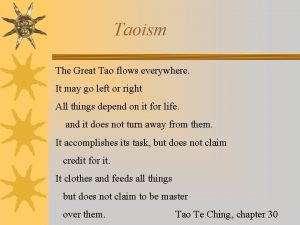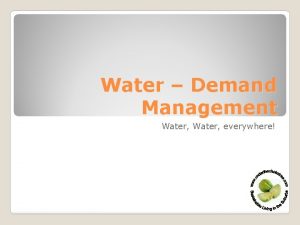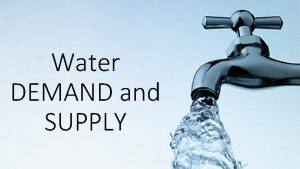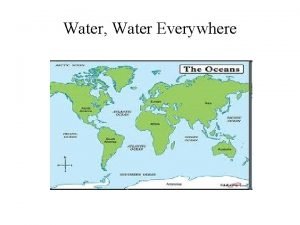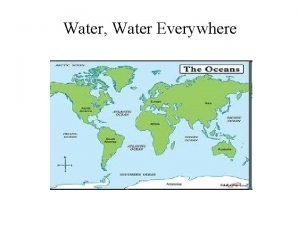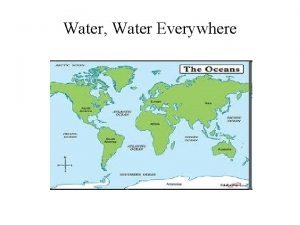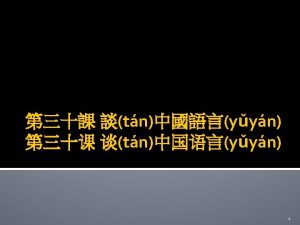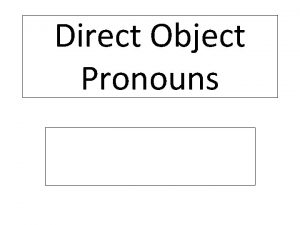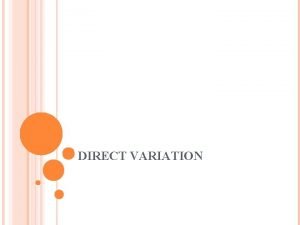Water Demand Management Water everywhere Review Direct water























- Slides: 23

Water – Demand Management Water, everywhere!

Review Direct water use Reducing direct water use Water foot print Indirect water use Reducing indirect water use What we will be talking about

Average Annual Household Usage >300 k. L/year = High to very high usage 200 – 300 k. L/Year = Around the national average 100 – 200 k. L/Year = low usage but more improvements possible <100 k. L/Year = Very low water usage Daily consumption (litres) x 365/1000 1 k. L = 1000 litres Review – Water Usage

Where it Goes

Identify household water uses Recording over a week the amount of water you use Validate your workings against records Identify any leaks Work out potential rain harvest Work out how much greywater is available Work out how much tank capacity you need The Water Audit

Grey water Rainwater Demand Management Options for Reduction

Direct Water Consumption

Think before you turn on a tap Investigate Insulate low water use appliances hot water pipes Check leaks, running taps & toilets (food dye; check water meter) General Rules

MULCH! & Soil organic matter Consider Xeriscaping your yard Install overhead veggie covers Install water efficient irrigation Store rainwater in the ground Consider a wetting agent Fit a trigger nozzle & water early or late Water more deeply less often Minimise impervious areas or divert to plants Garden

Sweep don’t hose! Wash cars with a bucket, on the lawn Use commercial car wash that recycles water Try a no-water car wash product Install tracks rather than solid drive Consider porous materials Garage and Driveway

Install low flow shower head Catch cold water in bucket while waiting for hot Limit to 3 minute showers (timer) Use a shower interrupt valve Shower with a friend (or consecutively) Don’t run tap while shaving or brushing teeth Wash hands in cold water Bathroom

Install a front loading washer Only wash full loads Hand wash small loads in a bucket – make a dolly! (pressure washer) Use a garden safe detergent (sodium salts, p. H, sulphur & boron) eg Planet Ark Limit use of bleaches Don’t wash clothes until they need it. Laundry

Wash veggies in basin or tub Don’t defrost under running water Boils as much water as you need Catch cold water while waiting for hot Install aerator on kitchen taps Low water use dishwasher or by hand Wash up once a day (or less) Kitchen

Install composting toilet “If it’s yellow……. ” Install dual flush or water efficient toilet Install sink/cistern combination Flush the toilet with warm up water Install touch sensitive flush on older toilets Put a full soft drink bottle in the cistern Toilet

The National Water Footprint refers to the total amount of fresh water that is consumed directly and is used to produce the goods and services consumed by the inhabitants of the nation Global Average = 1385 m 3/yr/capita Australia = 2315 m 3/yr/capita UK = 1258 m 3/yr/capita US = 2842 m 3/yr/capita Water Footprint

Indirect (Embedded, Virtual, embodied) Water Consumption

The average Australian’s daily water consumption – Direct = 180 litres Indirect = 2192 litres (food and industrial production) Virtual Vs Direct Consumption

"the volume of freshwater used to produce the product, measured at the place where the product was actually produced". It refers to the sum of the water use in the various steps of the production chain. Hoekstra and Chapagain Virtual or Embodied Water

1 1 1 1 2 1 1 Kilo of steak = 16, 000 litres kilo of butter = 18, 000 litres litre of milk = 4500 litres mug of coffee = 170 litres cup of tea = 20 litres Sandwich worth of bread = 180 litres kilo of spuds = 250 litres glass of wine = 300 litres egg omelette = 270 litres pork chop = 2400 litres kilo of rice = 6500 litres Food

The cotton for 1 shirt = 3000 litres 1 pair of jeans =11000 litres 1 sheet of A 4 paper = 12 litres Steel for 1 car = 360, 000 litres 1 kilo of plastic = 240 litres 1 personal computer = 190, 000 litres 1 pair of leather shoes = 20, 000 litres 1 kilo of wool = 200, 000 litres 1 litre biodiesel = 9000 litres Industrial Products

Eat less meat, specifically beef Eat less dairy Drink tea or better, water instead of coffee Wear other than cotton fibres Buy less “stuff” Grow your own food Waste less food How to reduce virtual water use

Review Direct water use Reducing direct water use Water foot print Indirect water use Reducing indirect water use Summary

For more details check our website
 Logos everywhere
Logos everywhere Class 8 english chapter 7 water water everywhere
Class 8 english chapter 7 water water everywhere Clil water
Clil water Unit 11 water water everywhere
Unit 11 water water everywhere Wegolook app
Wegolook app Hrm vs hrd
Hrm vs hrd Water and water and water water
Water and water and water water Inventory modeling
Inventory modeling Deficient demand and excess demand
Deficient demand and excess demand Individual demand vs market demand
Individual demand vs market demand Dependent demand operations management
Dependent demand operations management Magbigay ng halimbawa ng demand schedule
Magbigay ng halimbawa ng demand schedule Independent demand dan dependent demand
Independent demand dan dependent demand Module 5 supply and demand introduction and demand
Module 5 supply and demand introduction and demand Demand forecasting in managerial economics
Demand forecasting in managerial economics Distinguish between individual demand and market demand
Distinguish between individual demand and market demand Independent demand inventory management
Independent demand inventory management Demand management and capacity management
Demand management and capacity management I've been everywhere in canada my home
I've been everywhere in canada my home The great tao flows everywhere
The great tao flows everywhere Security that fits everywhere
Security that fits everywhere Linux everywhere
Linux everywhere Sexism meaning
Sexism meaning Lust vs attraction
Lust vs attraction



















